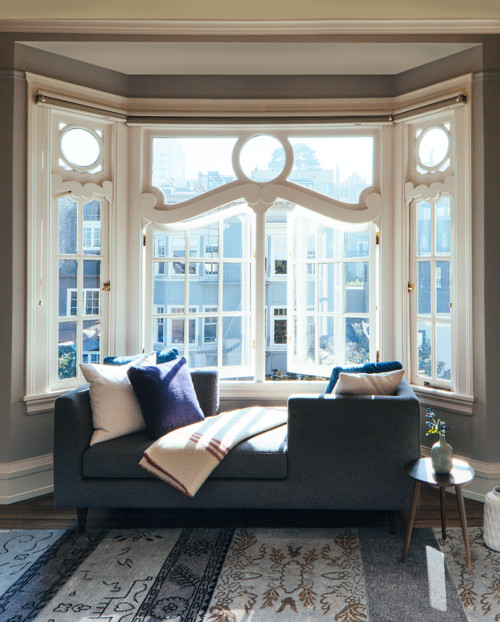Wondering how period double glazing will work for your historic windows?
A lot of heritage homeowners are afraid to lose the charm and unique period aesthetic that makes their windows so attractive. So, they sacrifice window performance to keep the heritage look.
And the truth is, a few years ago you couldn’t keep that rare historic character with modern window materials, tooling and techniques.
But, today, things are different.
With the latest advancements in patented window technology and the development of a process-focused approach to double glazing for historic windows, a lot of the limitations are gone.
When it comes to insulating the more intricate Victorian terrace windows, Federation style windows with the beautiful decorative coloured glass panes and charming colonial bars, and those old draughty Georgian casement windows, a high-performance window is totally possible.
This is great news for heritage homeowners because:
- You don’t have to keep dealing with draughts and high energy bills because your windows aaaaren't well insulated and properly sealed.
- You don’t have to live with the noise pollution that’s a given with older single pane windows.
- You can even enjoy enhanced security and peace of mind, knowing your old period aaawindows have been restored and reinforced, and are no longer vulnerable to modern worries aaaranging from break-ins to pesky insects.
And, with the special dry Retrofit Double Glazing system, designed to provide an effective solution to all the worries of maintaining your timber period window, such as:
- wood rot and decay,
- moisture build-up that can damage the window system,
- keeping period features like Victorian leaded lights or heritage hardware that may be broken, aaaand,
- making sure the windows move easily and can hold up to another century of wear and tear.
So you get to keep the look, feel and heritage character that makes your windows so valuable.
Here’s a look at the process of double glazing for period windows and three examples of period double glazing in action.
All of these are complex window styles with a challenging problem set. But, you’ll see that with an approach that focuses on lasting, sustainable solutions for historic-era windows, there really are no limitations to what can be done.
How Does Period Double Glazing Work?
One of the features that makes classic era windows, like your endearing Victorian sliders sash windows or those elegant Edwardian style windows, so irreplaceable is the timber joinery.
Your period windows were likely built from tough old-growth timber, which isn’t really used anymore because most of these old-growth hardwoods are gone.
This type of wood lasts.
That’s why you may have windows that are almost a century and a half old, and they are only showing minor signs of age. Old-growth timber is more resistant to termites and rot and has a more stable composition.
You also don’t want to lose the heritage style.
Your period windows may be seen as having cultural significance, being a reflection of a historical era. This is something you want to pass down to future generations.
So, in order to keep this value – the old-growth timber, the original look and function, and any other important details of your window – you can have your windows retrofitted instead of doing a full replacement. Instead of tearing out the whole window and putting in a new, double glazed window, the timber frame and sashes remain, along with the character.
Thermawood has created special tooling specifically for this task.
We remove the old single pane of glass, create a 15-degree slope in the window rebate, and then install a double glazing unit with the custom features your home needs for thermal and acoustic insulation.
We also developed a special drainage system (installed with in the 15-degree slope), which is one of the many reasons why Thermawood’s Retrofit Double Glazing system is different than other window systems on the market. It’s a dry glazing system so it prevents moisture build-up, wood rot, mould growth and deterioration of both the original frame and the new double glazing unit.
That’s a basic look at how retrofit double glazing works for period windows, but with historic windows, as you probably know from looking at yours, there are a lot of variables. Having worked on these windows for years, we’ve come across everything and know how to handle even the trickiest period retrofit double glazing jobs.
1. Federation Style Windows with Coloured Glass
One traditionally challenging period window when it comes to double glazing is the Federation style casement window with the beautiful coloured glass at the top and the colonial bars. These windows are found in a lot of heritage homes in Sydney and they’re truly striking – not a feature you want to throw away!
So, we figured out a way to retrofit double glaze the windows to improve the insulation and boost acoustic performance, and to help preserve these gems for another century.
We partnered with a specialist glass company that can laminate the heritage glass to a new piece of glass. As a result, the glass is much stronger, better insulated, and offers a quieter, more comfortable home.
Here’s how the process works:
- We remove the colonial bars and carefully take out those lovely green, pink, blue, or other aaacoloured glass panels.
- A specialist laminates the heritage glass.
- We put the now laminated heritage glass back during the retrofit and replace the colonial bars, aaaputting them back just as they were.
The windows literally look like the day they were first built – brilliant colour, the charming period design – but they perform like a 21st-century window.
2. Draughty Casement and Awning Period Windows
When you have a really old home – which is common with Georgian and Victorian windows, and even a lot of Edwardian windows, which may have been built around the turn of the 20th century – draughts are commonly a problem.
This is because the building has probably shifted. Over the years, even a slight gradual movement can create a sizable gap where your casement or awning sash opens out or up. Then, when you close the window, it may not be completely sealed because there’s always a gap.
As a solution, we developed a system where we can do a full draught seal around the frame of your casement or awning windows. Then, the windows are sealed from draughts, but you still get to use the winder function to open the casement sash out, or with an awning window, to push the sash out from the bottom, so you bring in all that fresh air.
During the retrofit process, a lot of period homeowners with casement and awning style windows want to have flyscreens installed. Having to put the flyscreen in and removing it when you open and close the window is, after all, a chore. But, of course, you want to be able to take advantage of the superior ventilation that makes these types of windows so functional.
So, we can machine in, not just the draught seals, but also a timber-rimmed flyscreen, which fits seamlessly into the frame. You can open, close and lock your period windows and the flyscreen stays in place.
3. Double Glazing Period Windows with Leadlights
Leadlights are found in a lot of period windows like the old Victorians, or they may be at the top of your heritage casement windows or even in a window above your doors. The period-era craftsmanship that goes into these works of art is remarkable.
Thermawood has a solution for double glazing with leadlights. What we do is we carefully take out the heritage glass by cutting around it. This ensures zero damage to the glass. Then, we give it to a professional leadlighter with whom we’ve teamed up to refurbish the glass.
We put the restored leaded light in our double glazing unit, where it is safely preserved, and then we complete the retrofit, putting the insulated glass unit into your period windows.
The thing you should know is, restored leadlights have an expected lifespan of 90 years. So, you get to pass down this piece of history to the next generations.
With Modern Techniques, There’s Nothing That Can’t Be Done with Period Windows
We’ll admit, these methods weren’t developed overnight. They are the fruits of years (and years) of work with double glazing and finding effective, lasting solutions for heritage issues.
But today, for the heritage homeowner, you get to reap the rewards. There are really no limits to what we can do with period windows.












